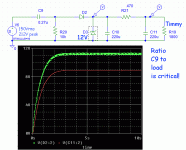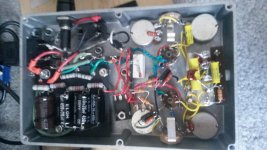I'm building a fender style tube-preamp with a Hammond 269bx PT, which is rated for 300v at 86ma on the hv secondary and 6.3v/2A on the filament winding. All in all it is up and running great when plugged into my 3 watt hi-fi tube amp. Now, I'd like to integrate an overdrive circuit that will require 9 volts, and would like to source it from one of the PT windings, both of which are underutilized as the only load is two 6av6 tubes (basically a 12ax7, but in individual tubes and not a dual-triode, so just a few ma on the hv and 600-600 ma on the heater winding). My overdrive will only require 4-5 ma. I was thinking of tapping the 6.3 volt winding, possibly with a voltage doubler, but if there was a way to use the main supply without having to drop voltage across a high value resistor it would be great. Best still if the solution has the smallest possible footprint. Any suggestions?
Thanks!
Joe
Thanks!
Joe
Is the heater winding grounded one side? That is common on radios and on the oldest Fenders. Guitar preamps today generally use a "center-tapped" heater winding. Trying to get DC out of this can crap-up the "AC" to your heaters and add buzz.
Are you sure this unspecified overdrive can need 5mA?
Are you sure this unspecified overdrive can need 5mA?
Yes, it's a Timmy circuit, and I have the pedal. I checked it with an ammeter to confirm. I'll be experimenting/breadboarding to see if I can build it without the controls, just fixed values for my favorite settings to keep it compact. I'm starting to think that maybe just adding a 2.1mm dc socket to the pre-amp and running a line from my Pedal Power brick is best, if a bit odd. Would save both space and hassle, and the preamp is going to live on my board anyway.
Thanks as always, PRR!
Joe
Thanks as always, PRR!
Joe
That's awesome. Will experiment and see if I can get that dialed in and make it fit in my enclosure.
Thanks!
Joe
Thanks!
Joe
"1800 Ohms" is 9V 5mA, an approximation to the Timmy circuit.
Sleeping on it, I realize the LM386 is not a constant resistance. About 20% of the current is resistive, but maybe 80% is "constant current", the power stage bias which is not real supply-sensitive.
With a steady voltage supply, this does not matter. But this capacitor-feed scheme is more "steady current".
The worst feature of the steady-current approach is that if the load is disconnected, the output SOARS, to over 200VDC in this case. Current available falls as voltage soars, so is not a serious shock risk, but the caps could burst. That's why a 12V Zener. With normal load this never does anything, but with light load it keeps things un-soared.
The LM386 is happy from 4V to 12V supply (with varying clip-level) so I'm not worried about it or the JFET. But it is never going to hit "9.0V" except by accident.
"C9" must be very generously over-rated. 400VDC rating may not be enough for 150VAC with steady high current (heating) in the cap. 0.27uFd 600V gets to be a fairly expensive part(s).
After sleep, I do prefer the Power Brick approach, a known-good low-risk supply.
Sleeping on it, I realize the LM386 is not a constant resistance. About 20% of the current is resistive, but maybe 80% is "constant current", the power stage bias which is not real supply-sensitive.
With a steady voltage supply, this does not matter. But this capacitor-feed scheme is more "steady current".
The worst feature of the steady-current approach is that if the load is disconnected, the output SOARS, to over 200VDC in this case. Current available falls as voltage soars, so is not a serious shock risk, but the caps could burst. That's why a 12V Zener. With normal load this never does anything, but with light load it keeps things un-soared.
The LM386 is happy from 4V to 12V supply (with varying clip-level) so I'm not worried about it or the JFET. But it is never going to hit "9.0V" except by accident.
"C9" must be very generously over-rated. 400VDC rating may not be enough for 150VAC with steady high current (heating) in the cap. 0.27uFd 600V gets to be a fairly expensive part(s).
After sleep, I do prefer the Power Brick approach, a known-good low-risk supply.
Thanks for putting so much thought into this. I was leaning toward the brick myself. Attached is a pic for reference. Right now there is no bass pot (fixed 20k resistor instead) , but I'm putting that back in, and moving the mid pot (the one with a single yellow cap above its terminals) to where the little red switch is (from my other thread, it adds the .047 in parallel with the .022 tone cap to shift the scoop from 700 too 400hz approx). Then, I'm going to put that cap mod on a slider switch on the front of the "pedal" and if I'm successful with the overdrive circuit, put that on another slider on the front (the two will be to the left and right of the nylon nut holding the tone stack terminal strip in place). So real-estate is at a premium, and the brick option will work very well in that regard.
Joe
Joe
Attachments
A standard Distortion/Overdrive pedal , the classic "741 with diodes" such as MXR Dist+ , RAT and 1000 others, or even "TL072/RC4558 with diodes" such as Tube Screamer, DS1 and 1000000 others is easy and reasonable to feed straight from high voltage +V , because it needs 1.5 to 3mA **constant**.
But a DIYer type "distortion" based on a Power Amp (even if tiny, an LM386 is that) is a poor choice in this case.
Being Class AB and designed to drive a speaker means that consumption is not only higher at idle (your measured 4 or 5 mA) , but will shoot higher when driven balls to the wall .
Higher and uneven consumption is what you do NOT want when pulling +250/300V down.
Yes, since it will live in a pedalboard, absolute best option is to add a DC jack and feed it from pedal supply.
Given that, you might as well give it its own enclosure and fooswitch 😎
I mean, you will switch it ON/OFF anyway and will mount footswitch *somewhere*, so .......
But a DIYer type "distortion" based on a Power Amp (even if tiny, an LM386 is that) is a poor choice in this case.
Being Class AB and designed to drive a speaker means that consumption is not only higher at idle (your measured 4 or 5 mA) , but will shoot higher when driven balls to the wall .
Higher and uneven consumption is what you do NOT want when pulling +250/300V down.
Yes, since it will live in a pedalboard, absolute best option is to add a DC jack and feed it from pedal supply.
Given that, you might as well give it its own enclosure and fooswitch 😎
I mean, you will switch it ON/OFF anyway and will mount footswitch *somewhere*, so .......
Thanks for the tip! I say it will live on my board, but it's just a convenience board. I'm not an actual gigging musician, so a slider switch will be fine in my apartment, and one less patch cable to ocd over. FWIW, I'll be using an LM1458. It and the JRC4559 are, as I understand, the main ones associated with the Timmy but this project is my introduction to op amps and, for that matter, solid state devices in general other than using MOSFETS for VVR (which you may have spotted in the picture) so I've quite a bit to learn about differences there.
Thanks again! Can't state enough how crucial help from the knowledgeable folks on these forums has been in getting me as far as I've gotten with the hobby.
Joe
Thanks again! Can't state enough how crucial help from the knowledgeable folks on these forums has been in getting me as far as I've gotten with the hobby.
Joe
> consumption ... will shoot higher when driven balls to the wall .
Only if there is a load with a good grip on those balls.
However, my mind has lost grip. "Timmy" appears to be a 4559 dual opamp, NOT the '386 that my loose mind recalled.
http://4.bp.blogspot.com/-dPkuhNlUqD0/T1ngxtOUQ4I/AAAAAAAABDs/ff-CKH4AfJQ/s1600/TimmyVero.png
With 10K load, the dynamic current above idle current is negligible.
Only if there is a load with a good grip on those balls.
However, my mind has lost grip. "Timmy" appears to be a 4559 dual opamp, NOT the '386 that my loose mind recalled.
http://4.bp.blogspot.com/-dPkuhNlUqD0/T1ngxtOUQ4I/AAAAAAAABDs/ff-CKH4AfJQ/s1600/TimmyVero.png
With 10K load, the dynamic current above idle current is negligible.
Not knowing "Timmy" , my cautionary note comes from one LM386 "distortion" being loaded with "something", if I don´t remember wrong 100 ohm or so, "to make it behave like an overdriven power amp instead of a preamp" ..... or some similar reason.
And there AC coupled load becomes a very real power supply load when driven hard.
Same as with capacitor coupled power amps ... which this also is.
By the same token, I have seen regular Op Amp based pedals where NFB gain structure was , say, a 100k Log pot plus a 100 or 220 ohm resistor to ground (with a series cap of course), the idea being to extract down from the last drop of gain .
RAT loads Op Amp with 47 ohm!!!!!!!!! when set to minimum gain.

For those not aware of that, typical minimum impedance expected by a standard Op Amp is 2k or higher, and peak voltage is severely limited below that.
Or to see it from another point of view, many are current limited to around 5mA *peak* .
My point being that often distortion pedals *do* pull higher current either overdriven or when set to minimum/unity gain ... which is quite counterintuitive.
And there AC coupled load becomes a very real power supply load when driven hard.
Same as with capacitor coupled power amps ... which this also is.
By the same token, I have seen regular Op Amp based pedals where NFB gain structure was , say, a 100k Log pot plus a 100 or 220 ohm resistor to ground (with a series cap of course), the idea being to extract down from the last drop of gain .
RAT loads Op Amp with 47 ohm!!!!!!!!! when set to minimum gain.

For those not aware of that, typical minimum impedance expected by a standard Op Amp is 2k or higher, and peak voltage is severely limited below that.
Or to see it from another point of view, many are current limited to around 5mA *peak* .
My point being that often distortion pedals *do* pull higher current either overdriven or when set to minimum/unity gain ... which is quite counterintuitive.
- Status
- Not open for further replies.
- Home
- Live Sound
- Instruments and Amps
- Sourcing 9 Volts for Preamp-Integrated Overdrive

